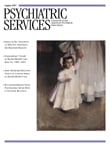Datapoints: Treatment for New Episodes of Depression
Despite concerns regarding depression treatment in primary care settings ( 1 ), few studies have examined how receipt of recommended services may vary across settings where new episodes of depression are diagnosed.
Veterans Affairs (VA) health system performance measures for new episodes of depression call for antidepressant coverage for at least 84 of the 114 days after the index prescription and at least three outpatient contacts for depression treatment during the 12-week acute treatment phase.
We examined VA depression treatment among all outpatients with new episodes of depression diagnosed in VA community-based outpatient clinics (CBOCs) or medical centers (VAMCs) during the first quarter of fiscal year 2003 (N=10,545). We assessed receipt of services overall and by clinic setting where depression was first diagnosed. A total of 6,963 patients (66%) were diagnosed in mental health clinics, and 3,582 (34%) were diagnosed in nonpsychiatric clinics.
Overall, 66% of patients received sustained antidepressant coverage, 16% had adequate follow-up visits, and 12% received guideline-recommended services for both measures. For patients diagnosed in mental health clinics, 4,505 (65%) received sustained antidepressant coverage and 1,309 (19%) had adequate outpatient follow-up, whereas for those diagnosed in nonpsychiatric clinics, 2,406 (67%) received adequate antidepressant coverage and 359 (10%) had adequate follow-up. Patients diagnosed in outpatient mental health settings were 1.9 times more likely than those diagnosed in nonpsychiatric clinics to have received adequate follow-up ( χ2 =136.8, df=1, p<.001). Compared with patients diagnosed in VAMCs, those diagnosed in CBOCs were less likely to receive adequate follow-up visits yet more likely to receive adequate antidepressant coverage ( Figure 1 ).

Overall, 17% of patients were dispensed at least a 90-day supply in their index antidepressant prescription. Patients diagnosed in nonpsychiatric settings were more likely to receive long-term initial prescriptions ( Figure 2 ).

Most VA patients did not receive guideline-concordant depression treatment. Although two-thirds of patients met criteria for sustained antidepressant coverage, it remains uncertain whether this indicates active medication management, and this measure may be less useful in primary care settings.
Acknowledgments and disclosures
The authors report no competing interests.
1. Katon W, Von Korff M, Lin E, et al: Collaborative management to achieve treatment guidelines. JAMA 273:1026–1031, 1995Google Scholar



